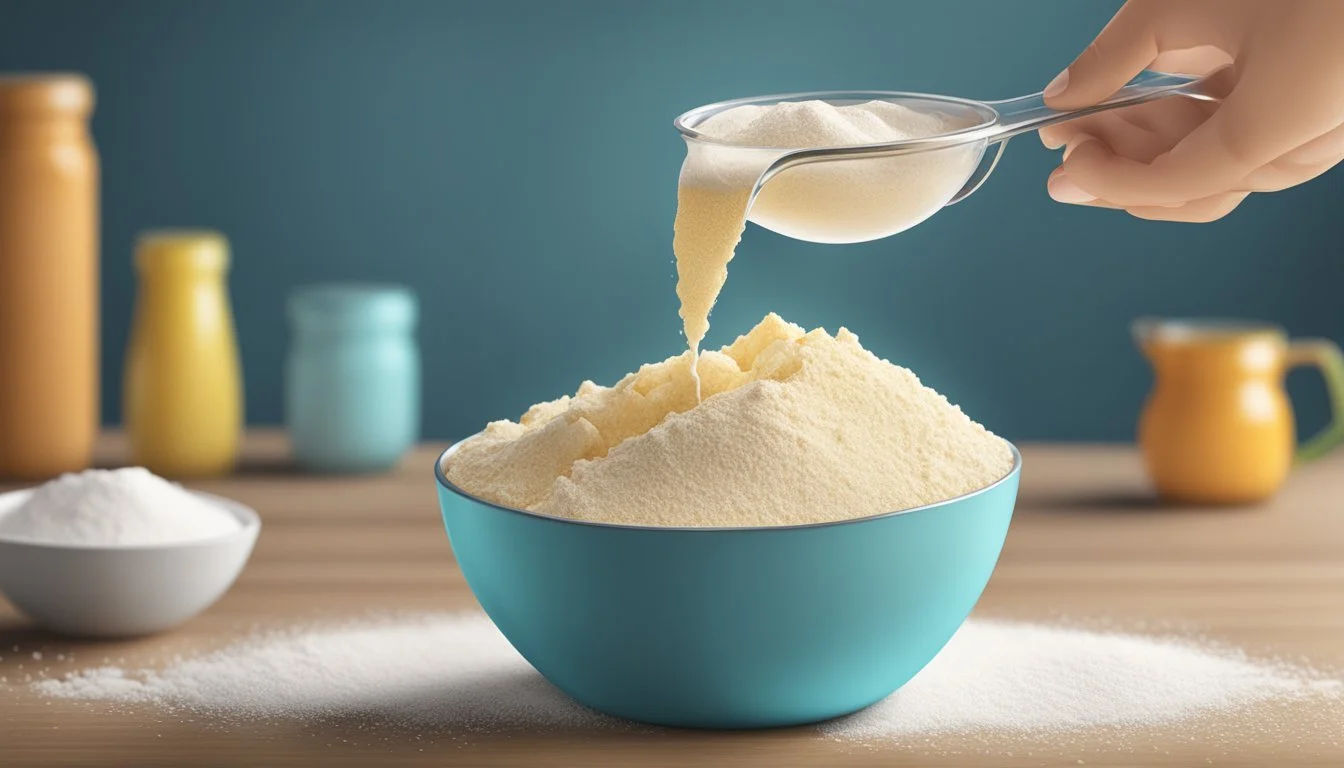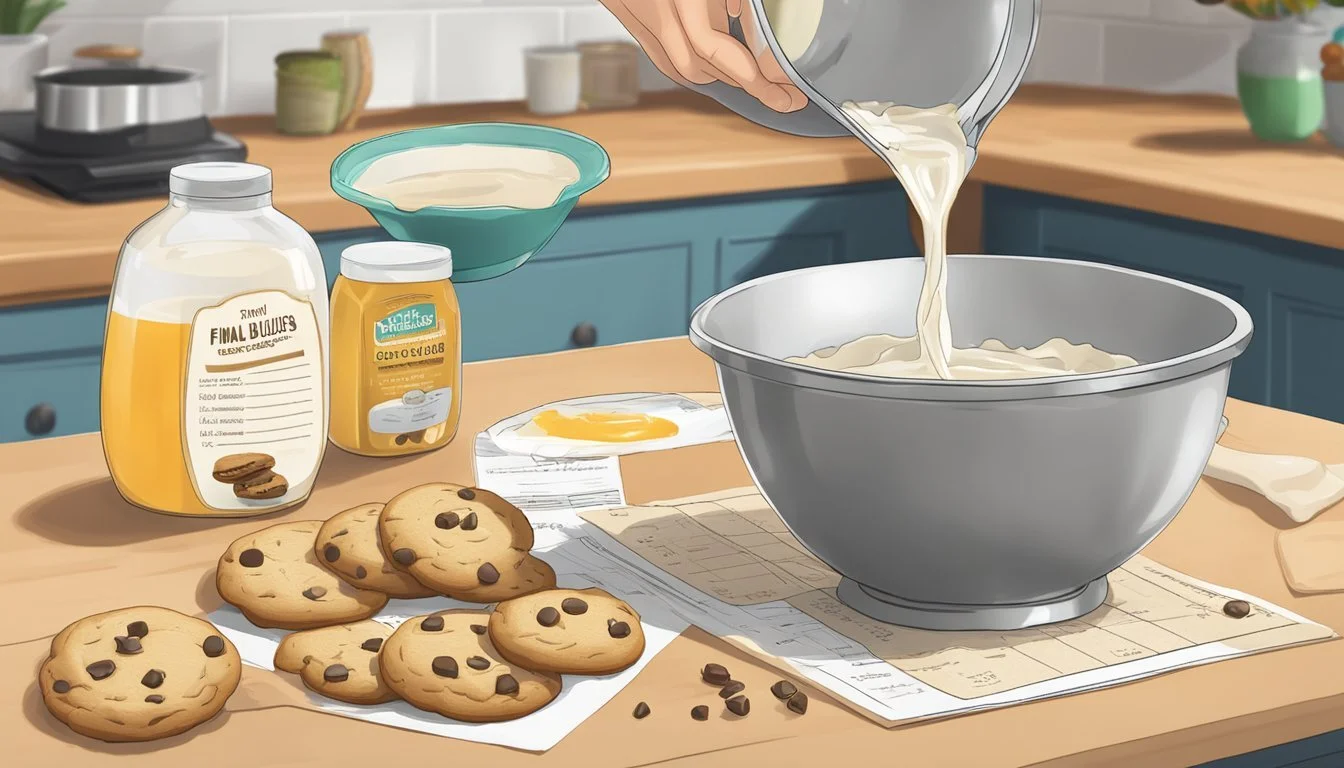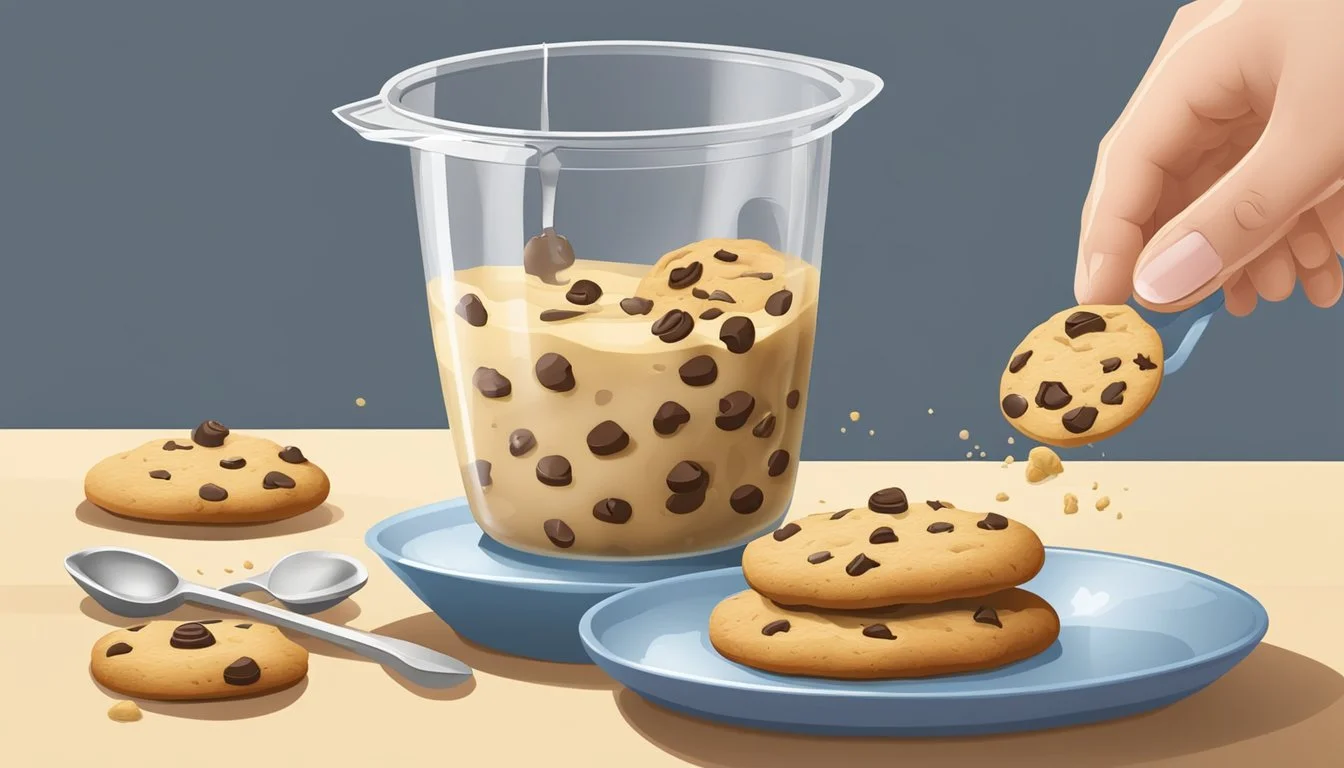How to Measure the Right Amount of Liquid for Cookie Dough
Precision Baking Tips
Achieving the perfect cookie dough consistency is crucial for baking cookies that meet your desired texture, whether it's chewy or crisp. The amount of liquid added to the recipe is a fundamental factor that influences the dough's moisture level and, consequently, the texture of the baked cookies. Precision in measuring liquids ensures that the cookie dough has the right balance, preventing it from being too dry or too wet.
Understanding how to measure liquids accurately is often the difference between good and exceptional homemade cookies. Bakers aim for the perfect dough that can hold its shape on a baking sheet while retaining the right level of tenderness and moisture after baking. Standard liquid ingredients in cookie recipes include water, milk, and different forms of syrups and extracts—each contributing to the overall flavor and texture of the cookies.
Cookie recipes are formulated with specific proportions in mind, so following liquid measurements to the letter is important for the success of the bake. A reliable set of measuring tools, such as graduated measuring cups for larger volumes and measuring spoons for smaller quantities, is essential. They should be levelled off to get an accurate measurement, ensuring the cookie dough comes together as intended by the recipe's creator.
Understanding Ingredients
In crafting cookie dough, one must pay attention to the role of liquids and the selection of appropriate ingredients, as they collectively determine the dough's moisture and texture.
Role of Liquids in Cookies
Liquids are pivotal in determining the final texture of cookies. They are involved in activating leavening agents, dissolving sugars, and binding the dry components together. For example, moisture from eggs helps proteins in the flour form gluten, giving the dough structure. When it comes to liquid ingredients like butter, eggs, and sugar, precision is crucial because an imbalance can lead to cookies that are either too hard or too cake-like.
Butter: Adds richness and tender texture due to its fat content.
Eggs: Serve as a binder and also incorporate air when beaten, aiding leavening.
Brown Sugar: Contributes to a moist and chewy texture due to its molasses content.
Selecting the Right Ingredients
The right ingredients in proper ratios are essential for a desirable cookie outcome. It's important to use ingredients at their intended temperatures as well. Butter should typically be at room temperature unless the recipe calls for a different texture; colder butter results in a puffier cookie, while warmer butter leads to a crisper result.
Flour: Base of the structure, too much can make the cookie tough.
Sugars (White and Brown): White sugar creates a crisp texture, while brown sugar imparts a soft, chewy quality.
Leavening agents (e.g., baking soda): React with moisture and acids to create lift.
Additional ingredients: Including chocolate chips, nuts, or oats for varying texture and flavor.
When approaching the wet ingredients, a baker must ensure that the liquids are measured accurately to maintain the delicate balance required for the dough. Whether it's the fat from the butter, the proteins from an egg, or the blend of white and brown sugars, each plays a crucial role in achieving the perfect chewiness, spread, and flavor distribution in the final cookie.
Measuring Tools and Techniques
In baking, precision and accuracy in measuring liquid ingredients are crucial for the desired outcome. This section will detail the tools required and techniques used to measure liquids for cookie dough accurately.
Types of Measuring Tools
When it comes to measuring liquids for cookie dough, there are two main types of tools:
Measuring Spoons: Ideal for smaller quantities, measuring spoons come in sets including tablespoons (tbsp), teaspoons (tsp), and fraction increments of these. For exactitude, the cook should fill the spoon to the brim and level it off.
Liquid Measuring Cups: These are typically made of transparent materials with marks indicating volumes in fluid ounces (fl oz), milliliters (mL), and cups. For accurate measurement, they should be placed on a flat surface and the cook should check the liquid level at eye level.
Kitchen Scale: A kitchen scale measures weight in grams or ounces. When a recipe calls for a liquid ingredient by weight, the person can use the scale for precise measurement. This is helpful for ingredients like water, milk, or oils.
Accuracy and Precision in Measurement
Accuracy refers to how close a measurement is to the actual value. When measuring liquids for cookie dough, the chef should aim for exact amounts by using the appropriate tool for the measurement called for in the recipe.
Always use the right size of the measuring spoon or cup for the amount needed.
Ensure the measuring cup is on a flat surface and viewed at eye level.
Precision is about the consistency of measurements. Reproducibility of measurements leads to consistent cookie dough every time.
For repeatable results, always use the same measuring tools and techniques.
For fractions of a tablespoon or teaspoon, using a kitchen scale might improve precision, measuring down to the nearest gram or milliliter.
Preparing Cookie Dough
The precise measurement of ingredients and the method of combining them are critical in achieving the perfect consistency and texture for cookie dough.
The Creaming Method
To begin preparing cookie dough, the creaming method is often used, particularly in recipes like classic chocolate chip cookies. It involves beating softened butter with sugar until the mixture is light and fluffy. This process incorporates air into the dough, contributing to a softer texture in the final product. For best results, one should use softened butter rather than melted, as the ability of the butter to hold air is crucial. It's recommended to cream the butter and sugar for at least 3-5 minutes with an electric mixer, or until the color lightens and the texture becomes noticeably softer.
Combining Dry and Wet Ingredients
Achieving a uniform cookie dough also involves the proper mixing of dry and wet ingredients. Firstly, one should whisk together the dry components—typically flour, a leavening agent like baking soda or powder, and possibly salt to ensure they are distributed evenly. In a separate bowl, the wet ingredients, which may include eggs, vanilla extract, or other flavorings, are combined. Gradually, the dry ingredients are added to the creamed butter and sugar mixture in parts to prevent over-mixing, which can lead to tough cookies. Care should be taken to mix until just combined; overworking the dough can develop the gluten too much and result in a chewier texture.
After the dough is formed, mix-ins such as chocolate chips, nuts, or dried fruit can be folded in carefully to maintain the dough's consistency. It is key to distribute the mix-ins evenly for uniformity in the cookies' appearance and taste.
Adjusting Liquid Quantities
When crafting cookie dough, the precise measurement of liquid ingredients is crucial as it directly influences the consistency and final texture of the cookies. Liquid components such as milk, syrup, honey, applesauce, and yogurt need to be adjusted carefully to achieve the desired outcome whether it's a chewy or crisp texture.
Impact of Liquid on Dough Consistency
The amount and type of liquid ingredients in cookie dough are pivotal in determining its moisture content. High moisture content typically results in cookies that spread more during baking, leading to thinner, crisper cookies. Conversely, less liquid produces a stiffer dough that spreads less, resulting in thicker, chewier cookies. For a balanced texture, a standard chocolate chip cookie recipe might incorporate a modest amount of milk to tenderize the dough without causing excessive spread.
Milk: Adds moisture and can tenderize the dough.
Syrup/Honey: Contribute to chewiness due to higher sugar content and moisture.
Applesauce/Yogurt: Can be used as substitutes for some liquids to alter moisture levels.
Technique is paramount when measuring liquids. It's advisable to use a glass or plastic measuring cup with a spout for liquids, pouring in the ingredient until it reaches the desired measurement at eye level on a flat surface.
Altering Recipes for Desired Outcome
To achieve the ideal texture and spread, bakers may need to experiment with altering the amount of liquid in a cookie recipe. This is a process of small adjustments and observation. If substituting one liquid ingredient for another, like using honey instead of syrup, one should consider the differences in sweetness and moisture content. Applesauce could be a substitute to reduce fat content but may also affect texture.
Adjusting liquid in a recipe:
Start with smaller adjustments, such as a tablespoon at a time, to maintain control over the changes.
Record the alterations and results for future reference.
If reducing liquid, compensate with a small increase in dry ingredients to maintain dough consistency.
Liquid Ingredient Effect on Texture Usage Note Milk Makes dough softer and chewier A staple in many recipes for a moist, tender crumb Syrup/Honey Chewiness; may cause more spread Substitute in equal parts for sugars to add chewiness Applesauce Adds moisture; can make cookies cake-like Use in reduced-fat recipes; may require adjustments for sugar Yogurt Adds moisture; tangy flavor Can replace milk or water to add a rich texture
Bakers should treat each batch as an opportunity for technique refinement. When scaling a recipe up or down, proportional adjustments of the liquid ingredients are necessary to maintain the desired cookie size and texture.
Baking Process and Considerations
Accurate measurement of liquids is crucial in making cookie dough, as it impacts the consistency and the baking process. Precision in baking time and temperature control ensures even baking and optimal results.
Cookie Baking Techniques
When preparing cookie dough, it's important to start by combining the liquid ingredients like water, milk, or melted butter with other wet ingredients such as eggs and vanilla extract. After measuring liquids precisely, one should gradually mix them with the dry ingredients — typically flour, baking soda, and baking powder — to form a consistent dough.
A key tool in achieving uniform cookies is the use of a cookie scoop. This helps ensure that each cookie has the same amount of dough, affecting how they bake and brown. Once scooped, placing the dough balls on a baking sheet with adequate space between them allows for proper heat circulation and even baking.
Baking Time and Temperature Control
The oven must be preheated to the correct baking temperature, as stated in the cookie recipe. This is commonly around 350°F (177°C), but varies based on the recipe. Utilizing an in-oven thermometer can provide a more accurate temperature reading and prevent over or under-baking.
Baking Time Cookie Thickness Temperature Control Shorter time Thinner cookies Higher heat Longer time Thicker cookies Lower heat
Cookies typically bake within 8 to 15 minutes. Monitoring the cookies towards the end of the suggested baking time can prevent burning. Cookies should be removed from the oven when they are just set and lightly browned, as they will continue to cook from residual heat once out of the oven.
Final Touches and Serving Suggestions
When preparing the ideal batch of cookies, one focuses on achieving uniform thickness for an even bake and explores variations in add-ins for unique flavors and textures.
Achieving the Perfect Cookie Thickness
To ensure that each cookie bakes uniformly, it is essential for the dough to have consistent thickness. For drop cookies, particularly large or small ones, the baker should use a cookie scoop or measuring spoons to attain uniform size and consequently, an even thickness. When using a rolling pin for types of cookies that require it, it is helpful to roll the dough between two rods or sticks of the same thickness to maintain uniformity. This results in a consistent dessert where each cookie is evenly baked with the desired texture and softness.
Drop cookies (e.g., chocolate chip cookies): Aim for a rounded tablespoon per cookie for standard size.
Rolled cookies: Place dough between parchment layers and use guides to achieve the ideal thickness (usually 1/4 inch).
Variations and Creative Add-ins
Adding mix-ins can transform a simple cookie dough into a gourmet dessert. The baker can introduce ingredients such as nuts, chocolate chips, or even a teaspoon of cocoa powder or jam in the center, for a burst of flavor. If the baker is making chocolate chip cookies, they might consider a variety of chocolate chip types - from dark to white chocolate. For those who enjoy nuts, walnuts or pecans can be mixed into the dough or sprinkled on top before baking.
Chocolate chip cookies: Add 1 cup of chocolate chips per batch.
Mix-ins: Fold in up to 1/2 cup of nuts, dried fruit, or other add-ins.
By maintaining even cookie thickness and experimenting with creative mix-ins, bakers can present a serving of cookies that not only meets the mark of a classic dessert but also showcases their cooking prowess with diverse flavors and textures.
Common Baking Mistakes to Avoid
Achieving the perfect cookie dough texture requires accurate measurements and attention to ingredient consistency. Heed to these common mistakes and ensure your baking yields consistently delicious results.
Measuring Errors and Their Effects
Correct Measurement Techniques:
Use a liquid measuring cup for liquids; fill to the appropriate line and check at eye level.
Measure dry ingredients using nested measuring cups, leveled off with a straight edge for precision.
Impacts of Measurement Errors:
Too much liquid can make cookie dough sticky and spread too thin when baked.
Insufficient liquid can result in dry, crumbly cookies that lack cohesion.
Temperature and Ingredient Consistency Issues
Importance of Room Temperature Ingredients:
Ingredients like butter and eggs should be at room temperature to blend seamlessly into the mixture and contribute to a uniform cookie dough.
Issues with Improper Ingredient Temperature:
Cold butter can lead to denser cookies that won’t spread adequately.
Overly warm butter can cause cookies to become too flat and greasy.
Consistent Baking Soda Measurement:
Baking soda should be measured accurately as it affects the rise and texture of the cookies. A slight excess can create an off taste and ruin the uniformity of the batch.
By focusing on precise measurements and maintaining ingredient consistency, bakers can ensure consistent results each time they prepare cookie dough.
The Science Behind Cookie Baking
Crafting the perfect cookie dough hinges on understanding the intricate science behind baking and the precise measurement of ingredients, especially liquids, which play pivotal roles in the chemical reactions and final texture of the cookie.
Chemical Reactions During Baking
When cookies are baked, several chemical reactions occur, each contributing to the characteristics of the final product. At around 212 degrees Fahrenheit, water in the cookie dough turns to steam, playing a critical part in the leavening process. The steam expands, helping the cookie to rise, while baking soda or baking powder decomposes, releasing carbon dioxide that further enhances this process. Dough with room temperature ingredients typically results in better reactions and a more uniform texture.
Sugars and fats melt during baking, contributing to spread and texture. Brown sugar, containing more moisture than granulated sugar, produces a chewier texture, whereas granulated sugar leads to a crispier cookie. The Maillard reaction, a chemical reaction between amino acids and reducing sugars, gives the cookie its golden-brown color and complex flavors.
Importance of Ingredient Proportions
The proportions of ingredients in cookie dough critically affect the end product. Using too much liquid can result in a cookie that spreads too thin or becomes tough when overmixed, as excess liquid can overdevelop the gluten networks. Conversely, too little liquid may prevent the dough from forming properly, creating dry and crumbly cookies.
A standard guideline for a balanced cookie dough is as follows:
Flour: The foundation, providing structure
Fat (such as butter or oil): Creates a tender texture and richness
Sugar: Sweetness and affects texture; brown sugar yields moist cookies, white sugar more crispiness
Eggs: Bind ingredients together and contribute to leavening
Liquid (milk or water): Should be measured precisely for desired texture
Baking soda: A leavening agent that reacts with acidic components
It is essential to measure these ingredients with precision; even a small deviation can alter the dough’s behavior and the cookies' texture. Technicians often recommend weighing ingredients for the most accurate and consistent results.






